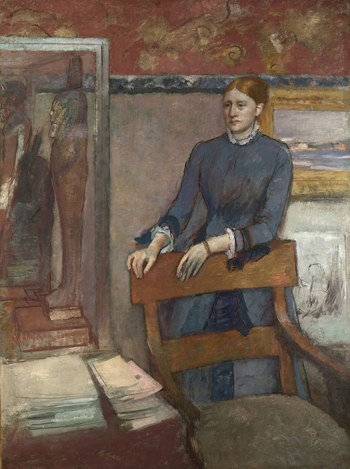|
THE
NATIONAL GALLERY MASTERPIECE TOUR : DEGAS’S
HÉLÈNE ROUART IN HER FATHER’S
STUDY
Gallery Oldham 18th September, 2021 to 8th
January, 2022
Reviewed by Jim Burns
Masterpiece – “A piece of work worthy of a master. One’s greatest
achievement”. Looking at the Degas painting that is the centrepiece
of this small but fascinating exhibition, I found myself wondering
if the word “masterpiece” really applies in its case?
The painting is interesting in some respects, but it doesn’t
strike me as showing Degas at his best. And the interest lies more
in what the painting contains (i.e. its subject-matter) than in any
purely painterly qualities. They, to my mind, have an unfinished
aspect I found disconcerting.
Hélène Rouart was the daughter of Henri Rouart, an industrialist,
art collector, and Impressionist artist who was a friend of Edgar
Degas. The location of the painting is significant in that it places
Hélène behind Henri’s empty chair, denoting that, although he’s not
physically there, he’s still present in spirit. This view is
enforced by the documents on his desk, some Egyptian artefacts in
the background, and, to one side of Hélène, paintings by Corot and
Millet. Henri’s treasured possessions are a key factor in the
painting, and perhaps she can be seen as one of them.
I can understand why the painting has caught the attention of art
historians and biographers. It relates to a minor figure in the
Impressionist movement who was closely involved with Degas. What’s
seen on the canvas provides a basis for documentation and
speculation, both factors being relevant to historians and
biographers.
We know who the woman is in the Degas painting. But what of other
portraits of women? The famous might easily be identified but there
are numerous paintings where the women are anonymous. They may have
been professional or part-time models, and few records survive of
who they were. Gallery Oldham has selected a number of portraits
from its permanent collection and used them to accompany the Degas
on display. And the staff there have, to their credit, attempted to
track down some details about the women in the paintings.
Knowing the names doesn’t necessarily guarantee that the paintings
will be accomplished or of real lasting value. Luckily, some have
both qualities in evidence. Harold Harvey’s
My Kitchen is attractive,
and one of the women in it is probably his wife, the artist Gertrude
Boddimar. By contrast, Patti Mayor’s bleak but striking
Mill Girl with a Shawl
doesn’t offer any clues to the identity of the model. She probably
was one of those “who toil without a name/and pass into the night”.
Joseph Southall’s colourful
Along the Shore catches the eye, and Thomas Mostyn’s
romanticised but appealing A
Fisherman’s Daughter possibly had a student from a local Devon
college for a model. I’ve just taken a sample from the works in the
gallery, and most are from early last century, but there are some
contemporary paintings on display and, among them, Peter Davis’s
Stay Safe, Mum stands
out. Painted in 2020, amid concerns about Covid, it’s impressive in
the way it catches the character of the person concerned. I
certainly preferred looking at it than at the nineteenth century
painting, Circe Offering the
Cup to Ulysses, by J.W. Waterhouse. A different idea of how
women were perceived by some male artists – as temptresses and
“idols of perversity”, as one writer put it – is well in evidence
there.
I enjoyed this exhibition as a whole and not just because it is
built around a famous name. The Degas painting is worth seeing, but
there are other good things nearby.
|
